From a basic standpoint, the inlay is used for filling a cavity and creates a hollowing among the tooth´s cusp. With an onlay, not only is it used for filling a cavity but it can also be utilized in other areas that are much larger. The onlay is in the nature of a dental crown, but the tooth´s surface is not fully covered. The same material is used to make them, and their purpose is the same, but with a different type of area that is covered in order to safeguard the area that had decay.
An inlay is molded onto the tooth´s chewing surface. This will replace the surface damaged by decay or another injury. When an inlay is created, the dental lab will receive an impression from our dental office. Once our dental office receives the finished inlay, the dentist will place it securely to the tooth’s surface without bothering the tooth cusp. The material used for an inlay is composed of either porcelain or composite. These will provide the most strength and durability as compared to other materials. The material used will determine the price for them. The good news is that the inlay will last for a longer amount of time. As our dentist decides to go with an inlay, it will be due to the current material used for the dental filling is not strong enough to endure the needs of the tooth. Having the inlay will provide a larger amount of support to the tooth.
With the onlay, we will replace the damage caused by decay, on the cusp and tooth surface. An onlay is designed for bigger cavity areas as opposed to an inlay or normal tooth filling. This will also allow the tooth to be stronger while remaining protected. As opposed to the inlay, the cusp and surrounding area may be included. The tooth will be prepared by the dentist as if a dental filling will be placed. The cavity will be drilled out and then cleaned once numb. After the cavity is cleaned, a temporary inlay or onlay will be set. An impression will then be made so that a permanent inlay or onlay can be made. After the dental lab makes the permanent inlay or onlay, they will send it to the dental office for placement. After the permanent inlay or onlay is set, they will be able to protect the structure of the tooth. An onlay and inlay may also be referred to as a partial crown. This is due to the similarities that both types contain although they only utilize a small part of the tooth.


